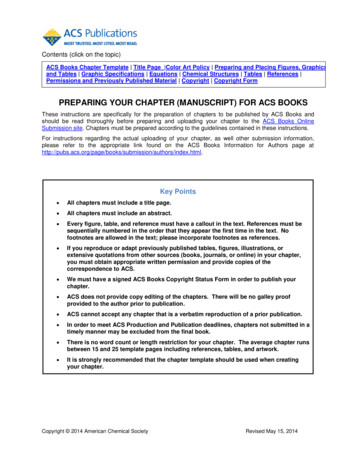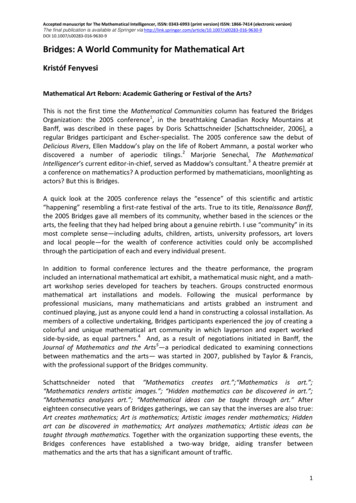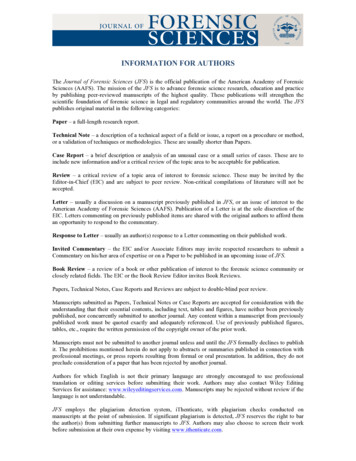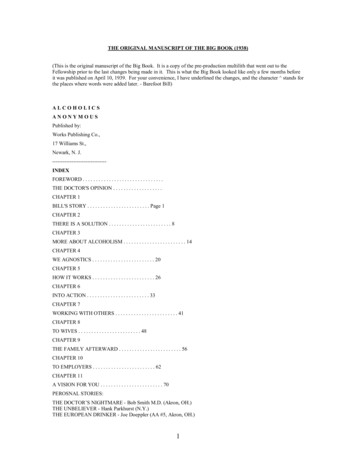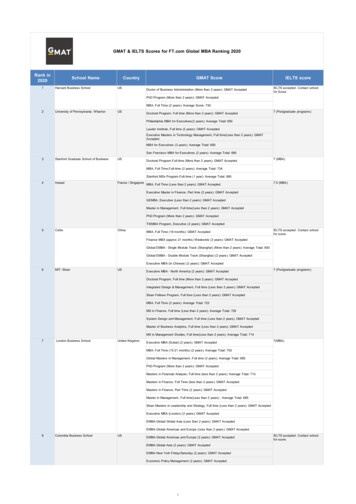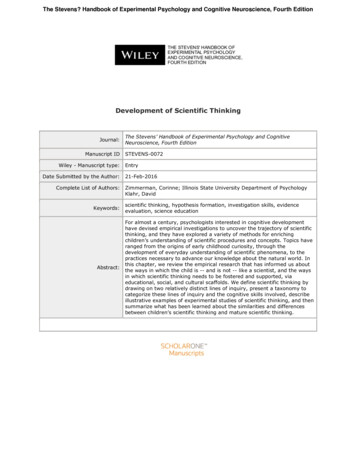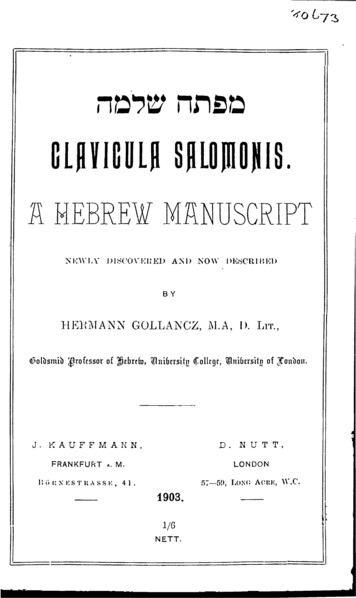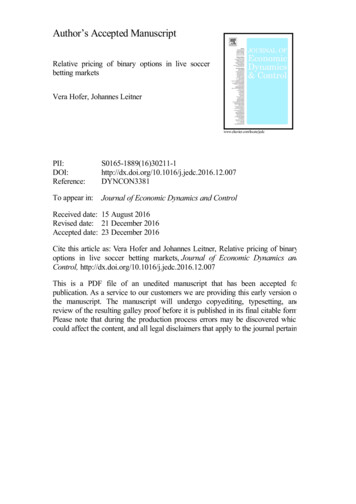
Transcription
Author’s Accepted ManuscriptRelative pricing of binary options in live soccerbetting marketsVera Hofer, Johannes j.jedc.2016.12.007DYNCON3381To appear in: Journal of Economic Dynamics and ControlReceived date: 15 August 2016Revised date: 21 December 2016Accepted date: 23 December 2016Cite this article as: Vera Hofer and Johannes Leitner, Relative pricing of binaryoptions in live soccer betting markets, Journal of Economic Dynamics andControl, http://dx.doi.org/10.1016/j.jedc.2016.12.007This is a PDF file of an unedited manuscript that has been accepted forpublication. As a service to our customers we are providing this early version ofthe manuscript. The manuscript will undergo copyediting, typesetting, andreview of the resulting galley proof before it is published in its final citable form.Please note that during the production process errors may be discovered whichcould affect the content, and all legal disclaimers that apply to the journal pertain.
Relative pricing of binary options in live soccer betting marketsVera Hofer, Johannes LeitneraaDepartment of Statistics and Operations Research, University of Graz, Universitaetsstrasse 15/E3,8010 Graz, Austria,AbstractLive soccer betting markets differ from other hinary options markets in that all fundamental information is observable, the options mature in less than two hours and the marketsare highly liquid. This study presents a new method for the identification of hidden information in market prices. The method is based on two independent Poisson distributionsand on a numerical algorithm for the aggregation of all market price information into onerational number. The method is applied to an empirical dataset of real time market pricesin 29,413 soccer games. The results indicate that the method selects the most profitablemarkets and allows for a significant improvement in average investment returns.Keywords:Binary options, sports betting, gambling, sports betting analytics1. IntroductionSports bets are cash-or-nothing binary options whose payout depends on the resultsof sporting events. The total annual volume of the sports betting market is estimated tobe one trillion US dollars, of which 70% is soccer betting (Keogh and Rose, 2013). Sportsbets are traded before the sporting event takes place or during the course of the event.The latter are called live, “in running” or “real-time” bets. Live betting makes up 70% ofall trading volume (Pantheon-Sorbonne and the International Centre for Sport Security,2014). Information technologies have changed the sports betting market substantiallyover the past decade and have served to make live betting much more relevant. Tracesof this evolution can be found in the literature. For instance, about a decade ago Levitt(2004) and Kuypers (2000) stated that once bookmakers announce market prices theyhardly adjust them at all. Nowadays, many bookmakers and betting exchanges providedatafeeds of their market prices via their own application programming interfaces. Marketparticipants have easy internet-based access to automated odds comparison services thatpublish highest odds and arbitrage opportunities for games across hundreds of providers.Companies such as Betradar supply information on events (red cards, fouls, etc.) directlyfrom the soccer stadium to bookmakers within seconds. This information is published onthe bookmakers’ websites and prices adapt immediately to crucial events (see Croxsonand Reade (2014)). Sports betting markets are affected by market inefficiencies. TheEmail address: vera.hofer@uni-graz.at (Vera Hofer, Johannes Leitner)Preprint submitted to Journal of Economic Dynamics & ControlDecember 29, 2016
most prominent inefficiency is the favorite longshot bias (Cain et al., 2003, Hwang andKim, 2015) that refers to mispricings of unlikely events.Sports bets are different from binary options traded on traditional financial marketsin several aspects. Firstly, the final state of the underlying of a sports bet is known. Thisis not the case for traditional binary options where the underlying can theoretically havean infinite lifespan. Secondly, unlike traditional options live bets are very short-lived. Asoccer game lasts for about 90 minutes and a bet can mature in a few minutes or evenseconds. Thirdly, in live sports markets all price-relevant information, e.g. scored goals,injuries, red cards etc. is publicly available simultaneously to all market participants.These unique characteristics of the options traded on betting markets allow powerfultests to be made of the market participants’ ability to process the available informationefficiently. Despite this fact most of the literature analyzes pre-game (non-live) marketprice data (betting odds). Franck et al. (2013) show that there are inter-market arbitrageopportunities when the market prices of bookmakers and sports betting exchanges arecombined. Only pre-game markets are used and the dataset dates back to the years 2004to 2006. Vlastakis et al. (2009) report that naive trading strategies generate abnormalreturns in a pre-game dataset from 2002 to 2004. Vergin and Scriabin (1978) developedstrategies for betting on National Football League games based on bookmakers’ pointspreads. They used 1969-1974 data to investigate the performance of the strategies.Using 1975-1981 data, Tryfos et al. (1984) also investigated different betting strategies.They suggested measuring the performance of a strategy in terms of profitability insteadof forecasting accuracy.Soccer betting markets offer a variety of bets on the final results of a game, on thefinal results of the first half, on the number of red cards or on the number of corners.The present study focuses on the analysis of the market prices1 for live bets on final gameresults. With respect to the trading volume, the most important live betting marketsfor final results are Asian handicap (AHC) and Over Under (OU) because these marketsdefine payouts for the bets that only depend on future goals.2 A handicap h Q, specificfor each AHC market, is added to the number of goals scored by the home team until theend of the game. If this value exceeds the number of additional goals scored by the awayteam, the bet on the home team has won. For each Over Under market a specific totalgoal target line l Q is defined. If the target is exceeded, the Over bet wins. If thetarget is not reached, the Under bet wins.31Conventionally, the term ‘odds’ is used for the payouts that a bettor receives in the case of a win.In this study the term ‘market price’ is used instead of odds to indicate that the payouts result from thetrading activity of market participants similar to prices on the stock exchange.2Most bookmakers (especially those operating in Asia) do not publish data on their turnovers. It isestimated that the Asian Handicap market represents up to 90% of the total trading volume (Hawkins,2014).3Besides the Asian handicap and the Over Under markets several other live betting markets exist.The most relevant are 1X2 and correct score markets. The 1X2 market defines payouts for three possibleoutcomes, a win of the home team (1), a win of the away team (2) or a draw (X). Correct score marketsprovide the opportunity to bet on a specific final result of a game, e.g. 1:4 or 3:2. 1X2 and correct scoremarkets have not been considered in this study. 1X2 market do not have significant trading volume atspecific scores. In correct score markets the probabilities of certain events can easily be derived, butthe bets entail high bookmaker fees which cannot be calculated exactly. Both types of markets areinappropriate for our purposes.2
As an example, Table 1 presents market data during a soccer game with four Asianhandicap markets and four Over Under markets. The market prices give information onthe possible payouts in the winning case. Assume that the current score of the game is0:0 and the game ends 1:0. A bet of 1 on the home team in the Asian handicap marketwith handicap h 0.5 will receive a payout of 2.316 because the handicap added tothe number of goals scored by the home team exceeds the number of goals scored by theaway team, i.e. 1 0.5 0. If the current score was 1:0 the bet would be lost becauseno additional goals were scored until the end of the game by either team and 0 0.5 0.A 1 bet on Under in an Over Under market with line 1.5 will yield a return of 2.429because the total number of goals is smaller than 1.5. Although goals can only be integershandicaps and lines are not restricted to integers. The reason for this will be explainedin the subsequent sections.Table 1: Sample data from live betting marketsAsian handicapMarket pricesHandicap Home Away-0.75 2.724 1.500-0.50 2.316 1.700-0.25 1.940 2.0000.00 1.570 2.530Over UnderMarket pricesLine Over Under1.50 1.600 2.4291.75 1.800 2.1702.00 2.149 1.8002.25 2.429 1.600The market price information in Table 1 is comparable to an option ladder of marketprices for options traded on traditional financial markets. The handicap h and the line lfor sports bets are analogous to an option strike price. Smaller handicaps relate to optionsthat are more out of the money. The investment decision of a rational participant in anyoptions market is based on risk adjusted returns. When several markets are available, theprobabilities of final scores implied by the market prices need to be compared and therisk of the bets needs to be quantified in order to identify the most attractive bet.A new method for solving this nontrivial problem is introduced in this paper. Themethod is called Implied Symmetry. It is based solely on publicly available market pricedata. It applies independent Poisson distributions with the parameters λ1 and λ2 modelingthe team strengths. The method derives the information on the probabilities of final scoresimplied by the market prices. The two parameters λ1 and λ2 are used for the comparisonof implied probabilities and for identifying relatively cheap and expensive bets. Thismethod provides the foundation for optimal trading decisions.In section 2 below the properties of Over Under and Asian handicap markets arepresented in detail. The mechanisms of sports betting markets are less well-known thanthose of traditional financial markets. In order to help understand the motives behind theresearch problems, the characteristics of the markets and the payouts are presented. Insection 3 it will be shown that market prices of sports bets do not allow the derivation ofimplied probabilities for final scores. This is the motivation behind the Implied Symmetrymethod that is presented in section 4. Based on this method a betting strategy is definedin section 5 that is supposed to maximize expected returns irrespective of the variance3
of the returns. A second strategy is proposed that minimizes variance of the returnsirrespective of their expected value. Section 6 shows the ability of the Implied Symmetrymethod to identify differences in probability valuations between markets. Market pricesdo not indicate these differences directly. This hidden information is revealed by theImplied Symmetry method. In section 7 the Implied Symmetry method is applied to adataset of market prices from almost 30,000 games. The results are completely in linewith the betting strategies formulated in section 5 and show statistically significant higherreturns and lower variances. In section 8 the results are summarized.2. Mathematical Properties of Betting MarketsThe mathematical model of soccer bets is based on a discrete probability distributionof final scores, Pt , as shown in Table 2. The current score of the home team is denotedgtH and the current score of the away team gtA at time t [0, T ]. Time T is the totalduration of the game. A soccer game generally lasts for 90 minutes and is extended forseveral minutes by the referee to cover ‘injury time’. The final scores are denoted gTH andgTA with gTH gtH 0 and gTA gtA 0. At time t [0, T ], the probability matrix Pt(t)contains the values pij 0 which are the true but unknown probabilities for the finalresults gTH : gTA i : j, i, j N0 . In order to simplify notation the superscript t is omitted(t)from pij .Home goals0123.Away goals123p01 p02 p03p11 p12 p13p21 p22 p23p31 p32 p33.0p00p10p20p30.···.Table 2: Probability matrix Pt of final scores in a soccer gameIn live betting markets Pt changes during the game. At the beginning of the game(t 0) P0 reflects all the relevant information such as home team advantage, recent teamperformance or injuries of key players. When t 0, Pt additionally reflects all information that is revealed during the game. This includes player disqualifications, weatherconditions, or the unanticipated strength of a team. It also includes the score of the game,since scoring events automatically nullify certain probabilities. If the current score is 1:0,the first line of matrix Pt contains zeros, i.e. p0j 0 j. In general, the probabilities pijare zero for scores i : j where i gtH or j gtA holds.Soccer bets are based on an estimate of the unknown true Pt and define a payout fora specific subset of all possible final scores. Such a subset might be a draw with scoresi : i where i 0 and with probability i 0 pii . The payout is directly related to theprobability of the subset. Based on Pt this relation is described in detail in the sectionsbelow for the Asian handicap market and the Over Under market.4
2.1. Asian Handicap MarketsAsian handicap markets offer the opportunity to bet on a home team or an awayteam win. A handicap h Q specific for each market is added to the future goals of thehome team. If gTH gtH h exceeds the future goals of the away team, gTA gtA , the beton the home team has won. The handicap h is set in such a way that preferably equalprobabilities of a home team win and an away team win are achieved and market pricesapproximately equal 2. This is the reason for the empirical observation that only aboutthree to five liquid handicap markets exist for any game at the same time (see Table 1).The choice of h will depend on the current estimate of the probability matrix Pt .There are three kinds of handicaps each with a specific payout mechanism: Integerhandicaps h Z, handicaps h Z 0.5 and linear combinations of these two. For integerhandicaps h Z the stake is returned, if gTH gtH h equals gTA gtA . Such neutralreturns are impossible for handicaps of the form h Z 0.5 (for example h 0.5 orh 1.5). Further Asian handicap markets are obtained as a linear combination of thetwo basic Asian handicap markets. This results in markets with handicaps of the form0.5n (Z 0.5), where n N. Examples of this type are h 0.125 or h 0.75. To easeexposition, the Asian handicap market with handicap h is denoted as AHC(h).Figure 1 illustrates the partition of matrix Pt for three AHC(0) markets. In the leftpanel the current score is 0:0, in the middle panel it is 1:1, and in the right panel thecurrent score is 1:0. White cells indicate where given the current score impossible finalscores are rated with zero probability. Since in Asian handicap markets only future goals01234 .01234 .0000111222333444.1234 .Figure 1: Three Asian handicap markets with handicap 0 at current scores 0:0, 1:1 and 1:0 (home teamscores in the rows, away team scores in the columns)are relevant for the payouts, the partitioning of the probability matrix in the right panelof Figure 1 changes depending on the current score.2.1.1. Integer Handicaps:(h)The payout ΠH when betting one monetary unit on the home team in a handicapmarket with integer handicaps at time t is (h) gTH gtH h gTA gtA qH . . .(h)ΠH 1(1).gTH gtH h gTA gtA 0otherwiseIn the case of a draw the stake is returned to the bettor and in the winning case she(h)receives the amount qH . Otherwise the stake is lost. A corresponding definition ofpayouts applies to the bets on the away team.5
The fair prices of bets on these markets are calculated under the assumption that thereare no bookmaker fees. In this case the expected payout for a bet on the home team orthe away team equals the stake, i.e. in this case one monetary unit.qH · WH 1 · WD(h)(h)(h) 1(2)(h)qA(h)WA(h)WD 1(3)· 1·The calculations require three probabilities. These are the probabilities of a draw(h)of a home win WH and the probabilities of the away team winning the game,These events are defined such that the handicap is already taken into considerationwith respect to the additional number of goals scored between the time t and end of thegame at time T . For instance a draw (D) is defined as a result where the handicap addedto the additional number of goals by the home team equals the additional number of goalsby the away team, i.e. gTH h gtH gTA gtA . These three probabilities are defined as:(h)WD ,(h)WA .(h)WD P (gTH gtH h gTA gtA ) pi gtH h,i gtA . . . h 0 i 0 pi gtH ,i gtA h . . . h 0 i 0(h)WH P (gTH gtH h gTA gtA ) i p1 i gtH h,j gtA . . . h 0 i 0 j 0 i h 1 pi gtH ,j gtA i 0(h)WA. h 0j 0(h)(h) P (gTH gtH h gTA gtA ) 1 WD WH(h)For instance, the definition of WD refers to the black diagonals in Figure 1 for thehandicap h 0. By rearranging (2) and (3) the fair market prices are given by(h)(h)qH (h) 1 WD(h)WH(h)qA1 WD(h).WA(h)(h)The probabilities WDh , WHh and WAh and consequently the market prices qH and qAdepend on t. However, for reasons of simplicity of notation, the time dependence is notmade explicit.2.1.2. Handicaps h Z 0.5:(h)For all bets with handicaps h Z 0.5 the payouts ΠH for betting one monetaryunit on the home team are defined as{(h)qH . . .gTH gtH h gTA gtA(h)(4)ΠH 0.otherwise6
The definition of the payout for bets on the away team is analogous. In contrast tointeger handicaps the payouts are based on only two conditions, i.e. the payouts are onlybased on two probabilities. In Figure 2, three AHC markets with h 0.5 are illustrated.01234 .0124 .30000111222333444.1234 .Figure 2: Three Asian handicap markets with handicap -0.5 at current scores 0:0, 1:1 and 1:0 (hometeam scores in the rows, away team scores in the columns)In a fair market the expected payouts of the bets equal the stakes. In the case whenbets of one monetary unit are placed on the home team or the away team respectivelythis meansqH · WH(h)(h) 1,(h)qA(h)WA 1.·For the calculation of the fair prices two probabilities are used. These probabilities aredefined as(h)WH P (gTH gtH h gTA gtA ) i 1 pij ,i 1 gtH j gtA(h)WA(h) P (gTH gtH h gTA gtA ) 1 WH .The fair prices of an AHC(h) market with h Z 0.5 are given by(h)qH(h)qA( 0.5)1 (h),(h).WH1 WA(0)Even though WHand WH are defined using the same components pij , the prices( 0.5)(0)of the bets are not necessarily the same, i.e. qH̸ qH because the AHC(0) marketneutralises the draw. The buyer of an AHC(-0.5) home bet will lose her stake if the resultis a draw, the buyer of an AHC(0) bet will get her stake back. As long as the probabilities(0)of a draw in a football game are not zero, i.e. WD 0, this has the consequence that( 0.5)(0)qH qH . Otherwise arbitrage would be possible.7
2.1.3. Other Handicaps:Markets with handicaps h 0.5n (Z 0.5), where n N are created by linear combinations of bets of the form h Z and h Z 0.5. For example, under the assumptions thatall market prices are based on the same values pij and that prices are fair the h 0.25market is equivalent to betting 50% of the stake on an h 0.5 market and 50% on anh 0 market. The AHC(-0.25) fair market prices are then derived as) 11 ( (0)(0)(0)( 0.5)( 0.5)· WH 1qH · WH WD qH22( 0.5)Using WH(0) WH yields1 (0)(0)· WH WD 12(0)11 2 WD( 0.25)qH (0)WH( 0.25)qHSimilarly, for the away team bet) 1()1 ( (0)(0)(0)( 0.5)(0)(0)qA · WA WD qAWD WA 12()21 (0)1 (0)( 0.25)(0)qAWA WD 1 WD22(0)( 0.25)qA 1 12 WD(0)(0)WA 12 WDThe Asian handicap markets for other handicaps such as 0.625 or -0.825 are definedanalogously.2.2. Over Under MarketsOver Under markets define bets on the total number of goals scored, gTH gTA . Whichteam scores is irrelevant. Each market is characterized by a specific non-negative valuel, referred to as the line that corresponds to the handicap h in Asian handicap markets.This line l Q denotes the total number of goals scored in a game that has to beexceeded such that the Over bet wins. Where this score is not met the Under bet wins.The line not only allows for a variety of bets. It also provides a tool for offering Overand Under bets with preferably equal probabilities. In contrast to lines l N0 , a draw isimpossible for lines of the form N 0.5. Analogously to Asian handicap markets, morecomplex Over Under markets can be derived from linear combinations of the two basictypes of Over Under markets. The Over Under market for line l is denoted as OU(l).8
2.2.1. Lines l N:Over under markets with lines l N are very similar to AHC markets with integerhandicaps. The payout for one monetary unit placed on Over is (l) gTH gTA l qO . . .(l)ΠO 1(5).gTH gTA l 0.otherwise(l)If the total number of goals exceeds the line l the bettor is paid qO . If the totalnumber of goals scored equals the line l the stake is returned. Otherwise the bet is lost.Figure 3 illustrates the three probabilities of the Over Under market with the line l 2.The matrix of final scores is split by secondary diagonals.0124 .300011223344.1234 .Figure 3: Over Under Markets with line l 2 for the current scores gtH : gtA 0 : 0 and 1:0 (home teamscores in the rows, away team scores in the columns)The fair market prices for given l are defined as follows:(l)(l)qU (l) 1 VX(l)VU(l)qO1 VX(l)VOThe three probabilities required for the calculation are defined as:(l)VX(l)VU P (gTH gTA l) P (gTH gTA l) l pi,l ii 0l 1 l 1 i piji 0 j 0(l)VO(l)(l) P (gTH gTA l) 1 VX VU(l)The probability VX refers to the black diagonals in Figure 3. It is analogous to thedraw in the Asian handicap markets but in order to avoid confusion with the term drawthe index X is used. Unlike in the Asian handicap markets the definitions do not dependon the current scores gtH and gtA . In the situation depicted in the right panel of Figure9
3 the probabilities p0j 0 j 0. Using these probabilities in the summation does notchange the results.2.2.2. Lines l N 0.5:Over Under markets with lines l N 0.5 are comparable to AHC markets withhandicaps h Z 0.5. The payout for one monetary unit placed on Over is{(l)qO . . .gTH gTA l(l)ΠO (6)0.otherwiseThe fair market prices are(l)qU1 (l)qO (l)VU1(l)VOIn Figure 4 the OU(2.5) market is illustrated for three different current scores.0124 .301234 .0000111222333444.1234 .Figure 4: Over Under Markets with line l 2.5 for the current scores gtH : gtA 0 : 0, 1:0 and 1:1 (hometeam scores in the rows, away team scores in the columns)In these markets only two partitions of the probability matrix exist(l)VU ⌊l⌋ ⌊l⌋ i pij P (gTH gTA l)i 0 j 0(l)VO(l) 1 VU P (gTH gTA l) .All other Over Under markets with lines 2.25, 1.75 or 1.125 (or more generally: linesof the form 0.5n (N 0.5) where n N) are linear combinations of these two markets.2.3. Extensions to Real Market ConditionsDue to betting exchanges such as Betfair.com the traditional one-sided role allocationof a bookmaker who offers bets and a gambler who accepts bets is no longer valid. Onan exchange each market participant can both accept and offer bets and therefore takethe role of a bookmaker. Bookmakers themselves use exchanges to hedge their positionsand oftentimes avoid taking risky positions but offer prices in a way to balance bets on10
the outcome of an event in proportions so that they make a profit regardless of whichoutcome prevails (Cortis, 2015).The absence of long term arbitrage opportunities justifies the assumption that pricespublished by various bookmakers and exchanges are very similar and that these pricesare the result of the trading activities of thousands of market participants. Each marketb i of the probabilities of the final scores. Theirparticipant i has an individual estimate Ptcollective trading activities on each market mk , k 1, 2, . . . influence the prices and thusb m of the true but unknown probabilities. Not all markets need torepresent an estimate Pt12bmbmimply the same probabilities, i.e. in general P̸ Ptt . It will be assumed below thatmarket particpants exploit the differences between bookmakers or exchanges and alwayschoose the maximum of all available prices.The definitions of fair market prices as described in the sections above are based on theassumption that E(Π) 1.4 Under real market conditions market participants are not(h)(h)(l)(l)offered the fair prices qH and qA , or qO and qU but these are reduced by a transactionfee called ‘vigorish’, v, or ‘juice’ that usually lies between 2% and 10%. Bookmakersonly publish these unfair prices qe. On betting exchanges prices are usually higher thanthe prices offered by bookmakers, but winners needs to pay 2% to 5% of their turnoverto the betting exchange. The effective prices, i.e. implied returns, on exchanges can beconsidered equal to the bookmaker prices qe. The observed unfair market prices have tobe adjusted for the vigorish for the analysis of the market assessments described in thefollowing sections. These are called adjusted prices subsequently.The unfair AHC(h) market prices offered by a bookmaker or betting exchange j are(h)(h)(h)(h)(h)(h)qej,H qj,H (1 vj ) and qej,A qj,A (1 vj ). Here qj,H and qj,A denote the fair prices for(h)(h)the home team and away team bets, respectively.5 These fair prices are not qH and qAsince these are based on the true and unknown probabilities pij . Instead, each market atb t of Pt caused by trading activities.each bookmaker is based on a different assessment PThese prices imply1(1 vj ) 11(h) (h)qej,Hqej,ARational gamblers are assumed to choose the highest available prices for an AHC(h)(h)(h)bet, maxj qej,H and maxj qej,A . Arbitrage opportunities exist if the following inequalityholds (see Appendix A):1(h)maxj qej,H1 1 1(7)(h)maxj qej,AIn general this inequality is not satisfied because market participants quickly exploitarbitrage opportunities. Selecting the maximum available market prices minimizes thetotal deviation from the fair prices. In the text below, the prices are assumed to be the(h)(h)maximum available prices maxj qej,H and maxj qej,A .4For simplicity the index and the superscript of the payout Π is omitted here.that the definition of unfair market prices only holds if the unfair market price qe is larger than1. If the fair price was 1.01 the bookmaker could not charge a vigorish of 5%. The market priceqe 1.01 · 0.95 0.9595 implies a sure financial loss for the bettor even if the bet is won.511
Assume that the market prices are qe1,H qe1,A 1.99, qe2,H 1.97 and qe2,A 2.01.The fair market prices for the two bookmakers would be q1,H q1,A 2, q2,H 1.98 andq2,A 2.02. These two markets assess the relative team strengths differently but theydo not provide an arbitrage opportunity. In this example the maximum available prices(h)(h)would be maxj qej,H 1.99 and maxj qej,A 2.01.All the above statements also hold for Over Under markets.3. Deriving Implied Probabilitiesb t and its partitions can be obNeither the probability matrix Pt nor its estimates Pserved on the betting markets. Only (unfair) market prices are observable. The questionis, how might probabilities be derived from market prices? Such probabilities are denotedas implied probabilities in the text below.(h)(h)Only two prices for betting on the home team qH and the away team qA exist onAHC(h) markets. If the prices are fair, i.e. the bookmakers do not charge any fees, thefollowing is true:(h)11qA(h) (h) 1 qH (h)(8)(h)qHqAqA 1The AHC(h) market is completely defined by one fair price and a handicap h. Thesecond price can easily be derived by (8). For integer handicaps h Z this implies that(h)the probability of a draw WD (note that ‘draw’ only refers to future goals considering(h)(h)the handicap) is unknown with given qH and qA . For all integer values of h, only theratios of probabilities can be derived. In an Asian handicap market with the handicap(0)(0)h 0 and the market prices qH qA 2, the prices imply that the probabilities of a(0)(0)home team win and an away team win are estimated to be equal, i.e. WH WA , buttheir values are unknown. Only handicaps of the form h Z 0.5 allow the derivation ofprobabilities implied by the market instead of only ratios of these implied probabilities.Since Asian handicap markets with h 0.5n (Z 0.5), where n N, are linear combinations of the payments for integer handicaps and markets with handicaps h Z 0.5,these markets inherit the characteristics of the integer Asian handicap markets such thatthe market prices only represent ratios of probabilities. The numeric values of the probabilities implied by the market prices remain unknown.The implications for the derivation of the Over Under markets’ assessment of theprobabilities are analogous. Only the Over Under markets with lines 0.5, 1.5, . . . give exactvalues for the implied probabilities. For the other markets only ratios of probabilities canbe calculated.If there are more than two Over Under or Asian handicap markets available, it needsto be checked whether the market prices imply different estimates of Pt . The marketprice data from Table 3 is used for a numerical illustration of the problem.The market prices of these three Over Under markets represent the markets’ estimates12
Market mMarket prices qeOverUnder1.62.41.722.2121.9Line l1232.252.52.
Binary options, sports betting, gambling, sports betting analytics 1. Introduction Sports bets are cash-or-nothing binary options whose payout depends on the results of sporting events. The total annual volume of the sports betting market is estimated to be one trillion US dollars, of which 70% is socce
